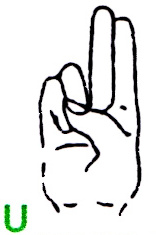U
U or u (spoken: [ ʔuː ]) is the 21st letter of the modern Latin alphabet and a vowel (even if it can be pronounced consonant under certain conditions). The letter U has an average frequency of 4.35% in German texts. This makes it the tenth most common letter in German texts .

The finger alphabet for the deaf or hard of hearing represents the letter U , with the closed hand pointing away from the body and the index and middle fingers pointing parallel upwards. The thumb rests on the palm.
origin
|
|

|

|
|

|

|
| Waw sign (Protosinaitic) | Phoenician vaw | Greek Ypsilon | Etruscan V | Latin V | Latin U |
The U shares a large part of its history with the V and the W , besides the Y and also the F are related to it.
Nothing is known about the sound value and meaning of the letter in the Protosinaitic script , the corresponding symbol represents a hook or a club with a round tip. In the Phoenician alphabet , the letter lost its tip and looked like a rounded Y. The letter was named Waw and was used to represent the phonetic value [w].
The letter was added to the Greek alphabet as Ypsilon . In early Greek the sound value of the Ypsilon was the vowel [u] corresponding to the [w ].
The Etruscans adopted the early Greek Ypsilon and its sound value. Over time, the lower point disappeared with the Etruscans, the letter took the form V. The meaning of the letter also changed: The Etruscan also contained the half-vowel [w] corresponding to the [u] (basically nothing more than a unsyllabic [u ]).
The Romans originally adopted the letter with both sound values. Initially, the letter was written in the pointed form adopted by the Etruscans. During the time of the later Emperor Claudius as censor from the year 47/48 a distinction between U and V began, the latter being given the sign wurde. However, the reform could not prevail. However, U and V were interchangeable. By the 18th century it was then accepted to use the round variant of the letter exclusively for the sound value [u].
Notation
The spelling of the small u with a straight line or hook above the letter , which can still be found in Germany today, comes from the old German Kurrent script . To distinguish it from the otherwise identical lowercase letter n, the u was given a dash. When, in the middle of the 19th century, the Latin cursive script with its differently shaped lowercase letter n became more and more popular, many scribes still retained the peculiarity of the u with line in the Latin script.
Quote
“To bring out u , the tongue is pulled back and lifted in its rear part towards the soft palate, while the lips are pushed forward and contracted to form a small circular opening, so that a fairly large resonance space is created in the front mouth, which causes the dull timbre of this vowel . This rounding of the lips was recognized early on as the main characteristic of this vowel: The u is a loud one with pointed lips and drawn together mouth V. ICKELSAMER Avj b . "